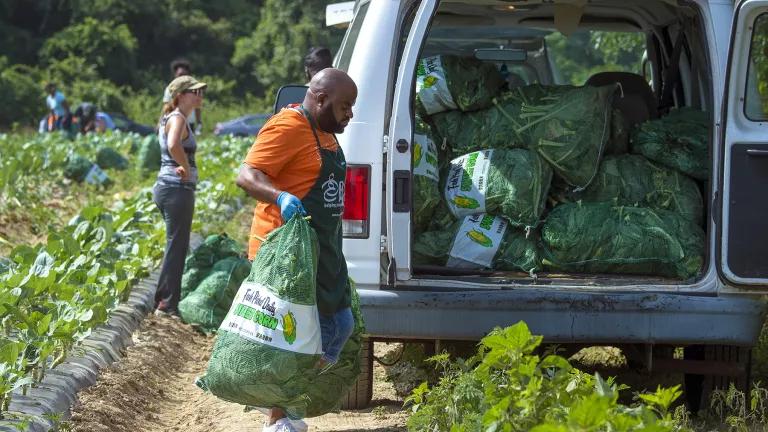Food Donations from Farms Guide

In many communities, there is a particularly acute need for donation of fresh fruits and vegetables and other farm-fresh products, beyond what is currently being donated. Whether growers live in surrounding areas or are part of the growing “urban ag” movement, they can play an important role in addressing food insecurity. NRDC has worked on two levels to engage farmers around food donation issues. In Nashville we conducted a survey of area farmers to gauge their interest in food donation, and in New York State we successfully advocated for passage of a law providing financial incentives for farmers to donate unsold food.
In this guide we share lessons learned from both processes. In addition, this package includes:
- Nashville farm survey instrument
- Nashville farm survey results
- A Farmer’s Guide to the Enhanced Federal Tax Deduction for Food Donation
- A Farmer’s Guide to the New York State “Farm to Food Bank” Tax Credit
- Addressing Food Waste and Increasing Food Donation Through the New York Farm to Food Bank Tax Credit
1. Gathering farmers’ input about the potential to expand donation of surplus farm products
To better understand on-farm losses of fruits and vegetables in central Tennessee, the Natural Resources Defense Council (NRDC) partnered with Second Harvest Food Bank of Middle Tennessee and the Nashville Food Project to survey area farmers. The survey aimed to quantify loss and clarify the causes of these losses, identify barriers to sale and donation of these products, and assess farmers’ interest in expanding donation and gleaning opportunities. The example survey instrument shows the questions that we asked, and the results document highlights the insights gained from participating farmers.
Lessons Learned
- We enlisted the help of farmers’ markets, extension agents, farmer affinity groups, nonprofit organizations, and the Second Harvest Food Bank to disseminate the survey tool. These organizations were essential for providing email addresses and phone numbers for farmers in their networks.
- Issuing surveys right after the winter holidays helps engage farmers when they tend to be less busy. However, in climates like Tennessee’s, the “winter down time” is fairly brief given the long growing season and early spring.
- We had significant challenges obtaining survey responses, especially by email, and soon broadened our reach by mailing hard copies of the survey and telephoning participants to walk them through the survey and record their responses. Phone calls were very labor intensive for NRDC and largely unsuccessful in obtaining responses, although phone conversations provided an opportunity for additional dialogue with farmers.
- To thank them for their time, respondents were offered a gift card to an area farm equipment retailer. One grower included a note stating the gift card incentive made it worth his time to complete and return the survey.
- In designing our survey instrument, we found it important to avoid potential confusion by clearly distinguishing donation of product harvested by the farmer and product that was obtained through gleaning by volunteers.
- The list of fruits and vegetables included in NRDC’s survey reflected crops commonly grown in the area surrounding Nashville. Similarly, the options we provided in the question about farm size was reflective of local conditions. Both should be tailored to the environment where the survey is being conducted.
- We also found it helpful to ask growers about their familiarity with federal tax incentives for food donation. Most were unfamiliar with the incentives which confirms the need to communicate more deliberately with farmers about those incentives. See the guidance that NRDC subsequently produced on this topic.
2. State policy strategies to expand donation of farm products
- Though billions of pounds of fresh fruits and vegetables in the United States go unharvested or otherwise never enter the food supply, farmers often cannot afford to pick, pack, and transport that food for donation. To help address this, policymakers in some states have passed legislation designed to reduce donation costs. Helping farmers cover the harvesting and transportation costs incurred when they donate agricultural products can increase access to healthy fresh food and reduce food waste.
- Partnering closely with a wide range of stakeholders, the state of New York enacted a tax credit for donations of agricultural products to the food recovery system to address the costs of donation. This tax credit allows farmers to claim 25 percent of the fair market value of qualified donations, with a maximum benefit of $5,000 per year, thus incentivizing them to donate their unsold products to those in need.
- The success of the New York “Farm to Food Bank” campaign was due in large part to the diversity and breadth of the coalition that developed to advocate for the tax credit. The diversity of the coalition’s members, both in terms of geography and the issues they focused on, helped the group address many of challenges it faced in trying to bring the tax credit to fruition.
- We documented the important role of this tax credit and lessons learned in the campaign in our report Addressing Food Waste and Increasing Food Donation Through the New York Farm to Food Bank Tax Credit. To help farmers navigate the changing tax landscape around food donation, NRDC created both “A Farmer’s Guide to the Enhanced Federal Tax Deduction for Food Donation” and “A Farmer’s Guide to the New York State ‘Farm to Food Bank’ Tax Credit.”


.jpeg.jpg?h=8ff71c51&itok=jRVQcaG9)